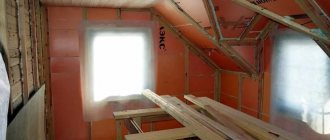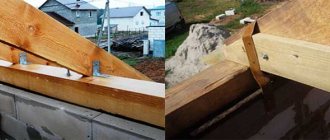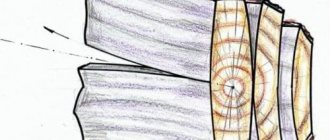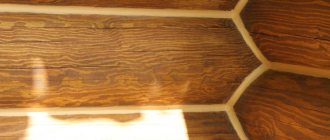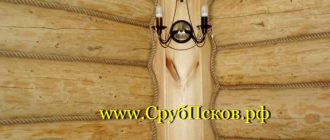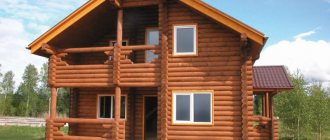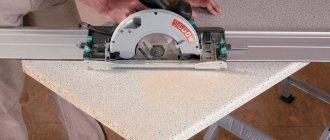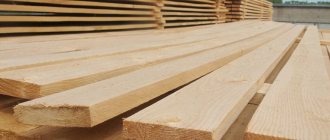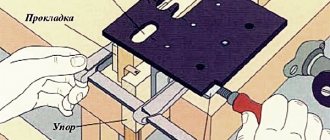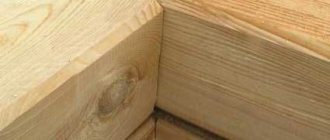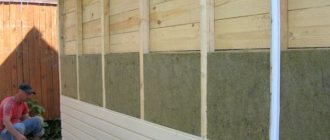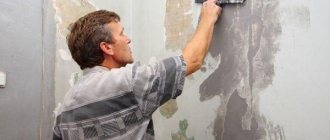Insulating the roof of a wooden house is one of the key stages of construction. The roof is exposed to the environment more than other structural elements, so without high-quality insulation you can forget about comfortable living in the house.
The lack of high-quality insulation allows the cold to freely penetrate into living spaces, so heating costs in winter increase to incredible levels. To avoid these problems, you need to know how to insulate a roof in a wooden house with your own hands and what materials to choose for the work.
Attic floor
Insulating the attic will help you do without insulating the truss structure if the attic is non-residential and used as a utility room.
On the other hand, insulating the ceiling surface will provide maximum protection from heat loss to the floor located lower than the attic. The work is carried out using the following technology:
- All cracks, voids between the floor beams and the ceiling are filled with felt, tow, and polyurethane foam is used;
- After this, the attic is lined with a vapor barrier membrane;
- The selected insulation is laid on top, and there should be no cracks or gaps between the layers;
- Then a layer of expanded clay is poured, which is good because it has the ability to retain heat, absorbing noise and vibration;
- The finishing layer is a sand-cement screed, a layer of roofing felt, or another synthetic analogue, after which you can lay a wooden floor and lay chipboard slabs.
If the building is old, before organizing insulation, the roof is carefully inspected for cracks and the general condition of the ceiling. If necessary, rotten beams are replaced, wood parts are treated with moisture- and fire-resistant compounds, antiseptics against mold and insects. When the impregnations have dried, preparatory work is carried out before sheathing the attic.
If there was insulation on the surface that has not lost its properties, a new layer is laid on top. For example, if the original subfloor was made of sawdust and clay, you can install sheathing and lay mineral wool mats. If the old insulation has become unusable, it should be completely removed, new one laid and sewn up.
Video description
Watch this video for possible errors and their correction when insulating the roof:
Attention! It is important to monitor the density of the thermal insulation material. The further result depends on this. If gaps form in the insulation, they must be filled. This can be done using scraps of thermal insulation.
You also need to remember about fixing the insulation. To do this, you need to drive nails into the rafters and once again tighten the threads in a zigzag. Upon completion of the process, you need to make the sheathing using slats or boards. Their thickness should be at least 2 cm.
Insulation of gables
Pediments are usually insulated from the outside together with the facade. But if this work is not planned, you can make thermal insulation from the inside.
Attention! To insulate the gables you will need beams. If they are not there, you can replace the material with boards. In this case, it is necessary to measure their width so that it matches the width of the heat-insulating material.
Gables can be insulated using dry blowing. Source oboiman.ru
To insulate gables, you should follow 6 steps:
- Fastening on the surface of the slats to ensure ventilation between the heat-insulating material and the wall (in this case, you must adhere to the distance parameters - half a meter vertically, about 10 cm horizontally);
- Placement of the vapor barrier membrane on a plane of slats (here you should pay attention to the position of the slats and correct unevenness, and the film should not sag);
- Installation of vertical racks in the form of beams or boards, followed by fastening with screws and metal corners (it is necessary to compare the distance between the beams - it should be 2 cm less than the width of the insulation);
- Filling the space with heat-insulating material (the insulation should fit tightly - this is an indicator of the correctness of the previous steps; if the mats fit easily, then additional reinforcement will be required);
- Re- attaching the vapor barrier ;
- Installation of sheathing.
After all the work has been completed, you can begin the final finishing of the room. Before purchasing material, you should analyze the further use of the room. For residential attics, drywall and finishing putty are suitable.
Advice! If the attic is cold, you should give preference to materials designed for low temperatures. The finish will quickly deteriorate if operating conditions are not followed.
Wooden house and roof insulation
Initially, the installation of a gable roof cannot resist the ingress of moisture into the house, and heat retention leaves much to be desired; accordingly, a craftsman will need to do both hydro and thermal insulation with his own hands. If everything is left as is, then almost a quarter of the heat loss for the entire house will relate specifically to the roof.
Thermal insulation of a house roof
The specific material is selected in advance, based on the funds allocated for repair work, since this decision can significantly change the final estimate. Specifically for a wooden room and the roof on it, stone mineral wool is suitable. Which vapor barrier is better does not matter, since the characteristics of the materials are approximately the same.
The material is purchased either in the form of solid mats or in the form of separate slabs, the size of which is selected based on the distance between the rafters. In any case, all created cracks are additionally sealed with sealant. You also need to take into account that the structure of mineral wool is such that after some time the material will shrink. A layer of waterproofing is applied on top - individual layers are placed offset, and the resulting joints are treated with sealant
You should pay special attention to construction tape, since replacing the insulation with your own hands is very difficult.
The material itself must have a porous structure so that it can “breathe,” since a certain amount of moisture will still accumulate in it. The fact is that in warm rooms, in any case, water evaporation will rise, and we also must not forget about the difference in temperatures, which is characterized by the appearance of condensation. The design of superdiffusion membranes makes it possible not to allow water to pass through, but allows steam to escape.
Waterproofing can be achieved by installing reinforced film or polyethylene yourself, but then you need to leave a small space between the insulation and its layer. This is required for the wooden house itself, so that air flows move freely through it - otherwise deformation of the wood, the appearance of mold, fungi, and rot are inevitable. Much depends on certain operating conditions, but there is no point in making such a gap more than 10 cm.
The material will be fixed to the rafters using a construction stapler, and the roof will be insulated from the inside with a layer without breaks or joints. The construction of a wooden house involves the creation of a vapor barrier layer, otherwise the roof will suffer from rotting. It is required to cover the insulation on the opposite side, where the waterproofing layer is located, and the specific material is selected individually.
Specifics of insulation of truss structures
Despite the apparent simplicity of the process of thermal insulation of the rafter frame, this is a very serious stage. Firstly, the roof is the lightest building structure, which should not be made too heavy. However, insulated slopes are required to protect owners from all kinds of weather phenomena, just like load-bearing walls, otherwise there is absolutely no point in insulating the attic.
Secondly, the enclosing coating, together with the components of the roofing pie, is in direct contact with the lower layers of the atmosphere on the outside, and on the inside in contact with the domestic environment with its characteristic microclimate.
The temperature difference on both sides, by definition, creates conditions for the accumulation of condensation in the thickness of the roofing system. In addition to them, steam formation occurs, which is characteristic of the premises being used.
Taking into account the listed factors affecting the thermal insulation layer in the roofing pie, special requirements are imposed on the material chosen for the arrangement.
Thermal insulation of rafters should be:
- lightweight so as not to create additional load on the supporting structures of the building;
- maximum resistant to moisture, which, even with ideal thermal insulation protection, still penetrates or forms in the roofing pie, albeit in small quantities;
- non-flammable, in extreme cases, slightly flammable or simply does not support combustion;
- noise-absorbing, i.e. capable of extinguishing sounds of varying power and origin;
- minimally thermally conductive, so as not to increase the volume of the structure with optimal ability to retain heat.
It is important that the material chosen for the thermal insulation layer does not wrinkle or settle under its own weight during its service. Because If the rafter structure is being installed, the thermal insulation will definitely be located at an angle.
If the insulating layer slides somewhat towards the base over time, exposing the ridge area, heat loss will increase by approximately 40%. Therefore, when selecting a material, you should choose the position whose labeling indicates “for pitched roofs.”
Thermal insulation options for rafter systems
The task of insulation is not to heat up the air mass; they are required to retain the heat supplied by the heating and not let in low temperatures outside. In summer, the same thermal insulation prevents the penetration of high temperatures, which on hot days on the roof often reach + 90ºС.
The materials used to construct the insulation system for pitched roofs are divided into two basic groups:
- Cotton ones. These include varieties with a fibrous structure: stone wool, glass and slag wool, etc. Their insulating qualities are imparted by the air that fills the space between the chaotically intertwined fibers. Wool can be either hard or soft, i.e. crushable.
- Foam. Options with a “foamed” structure, which are a collection of closed bubbles filled with an inert gas or ordinary air, which acts as an insulator. These are rigid slab types of insulation.
In the construction of the insulation system for rafter systems, materials characterized by low thermal conductivity are used. Its value usually does not exceed the standard limit of 0.04 W/m°C, which is typical for almost all types of roof insulation.
Specifics of cotton wool insulation
Cotton insulation easily allows evaporation into itself and, in the same way, part with the moisture found in its thickness. To prevent water from retaining in fibrous insulation, which significantly reduces the insulating properties, roofing wool is hydrophobized - the fibers are coated with a water-repellent substance.
The hydrophobic shell prevents the fibers from getting wet, on which moisture only accumulates, and when the drop reaches volume, it rolls down or is evaporated by an air flow. Therefore, wool used to insulate rafter frames is classified as a vapor-permeable, but at the same time non-wet material, which is extremely important in the construction of roofs.
During operation, wooden rafter structures emit a certain amount of moisture that must be removed. Therefore, the best option when installing an insulation system in the space between the rafters is considered to be cotton wool, which promotes the natural drying of wood structures.
From the inside, i.e. from the premises, the wool is covered with a vapor barrier membrane. It prevents the penetration of vapors into the insulation, but still partially lets them through. On the outside, the cotton thermal insulation is covered with a water-repellent polymer film, between which and the insulation a ventilation gap of 3–5 cm is left.
If a superdiffusion membrane is used as waterproofing, then the ventilation gap is not provided. The membrane spontaneously releases condensation formed in the insulation into the atmosphere, but prevents rain and melt water from penetrating the insulating layer.
It is, of course, more expensive than ordinary and reinforced polyethylene film, but it allows the use of narrower rafters for insulation, which brings considerable economic benefits.
Features of foam insulation boards
The subgroup of foam insulation includes all kinds of expanded polystyrene foam, polystyrene foam, polyurethane foam, etc. All of them are divided into vapor-permeable and vapor-tight options.
The ability to transmit household fumes depends on the manufacturing method of the material. For example, extruded polystyrene foam allows moisture to pass through in minute quantities, because its cells are tightly sintered together by the walls. There is no space left between them. In addition, the closed shell of the bubble eliminates the slightest attempts at water penetration.
Materials created by extrusion have the lowest vapor permeability, which makes it possible not to protect the insulation with vapor barrier films. However, the need for a ventilation duct in case of removal of condensate and a small volume of steam still remains.
Polystyrene foam - foamed polystyrene that has not passed through the extruder allows vapor to pass through. Between its cells there are channels that facilitate the penetration of moisture and its removal from the thermal insulation body through ventilation. When using it as roof insulation, it is necessary to use vapor and waterproofing layers and install ventilation ducts.
Foams are represented by rigid slabs, which, unlike soft wool, do not wrinkle. Although it can be installed in the space between the rafters, foam insulation is generally installed on top of the rafters or on the inside of the room.
The fact is that it is difficult to cut out a material that rigidly retains its shape so that it completely fills a cell in the rafter system. There will still be some weakened thin line between it and the rafters, which contributes to the formation of cold bridges.
In addition, extruded insulation materials do not absorb moisture, which will inevitably be released by the wooden elements of the system. Therefore, when laying between the rafters, only foam plastic can be used - insulation that can allow vapor to pass through.
Foamed thermal insulation with minimal vapor permeability is available in the form of slabs. Most of them are equipped with a technological edge, which greatly facilitates the laying of the material. Thanks to the edge, the thermal insulation layer, installed along the rafters or from the inside, turns out to be almost monolithic, preventing the formation of cold bridges.
What is dew point
Suppose that at a given temperature the relative humidity is 60%. This means that the air contains 60% of the maximum possible amount of water vapor that the air can “hold” when fog has not yet formed and dew has not yet fallen. If the temperature drops, the relative humidity - for the same absolute amount of steam - will become higher. With a further decrease in temperature, the relative humidity will reach 100% - they say that the “dew point” has been reached. This will cause condensation to form.
If you bring a cold object from the street into a room where the relative air humidity at a temperature of 20-25° is 50-60% in winter, it will immediately fog up, since near its surface the air will cool below the “dew point” and condensation will form.
The same thing will happen if warm air from the room penetrates the thickness of the insulation (for example, mineral wool) adjacent to the cold roof. As the air cools, the relative humidity will increase until it reaches 100%, and then moisture will form in the form of droplets of condensation, which will freeze with further cooling - and the insulation will gradually turn into ice.
To prevent this from happening, two problems need to be solved:
- do not let steam from a warm room into the thickness of the insulating material;
- if steam somehow got there, then immediately take it outside.
How to make attic insulation
Attic insulation, or floor insulation, is quite simple. This method is used when it is decided to leave the attic cold. It uses either bulk materials, which include sawdust, expanded clay, granules, etc. or slab, roll and sheet insulation.
RostikaFORUMHOUSE participant
The ceiling is less demanding on materials: there is no slope, so there is no risk of the insulation shedding and exposing the surface.
Despite all the simplicity of floor insulation and low requirements for materials, this process also has features and subtleties:
- any thermal insulation material must be insulated from warm air rising from heated rooms;
- You cannot cover the heat-insulating material with any film other than wind protection, this will prevent the free release of heat, which contains steam, from it;
It is also important what the ceiling is made of. If it is made of hollow reinforced concrete slabs, then it is necessary to insulate their ends; if the floor is made of wooden joists and the insulation is done between the joists, it is advisable to place the vapor barrier film close to the heat-insulating material.
Be sure to insulate the Mauerlat!
A cold attic with an insulated ceiling must be ventilated. To do this, they make dormer windows, use ventilation ridges, etc., and there must be holes in the eaves for the passage of air from the street. The attic temperature should be almost the same as outside.
Features of a warm roof
If you want to create a high-quality and reliable roof, under the arches of which there will be a warm and cozy attic suitable for all-season living, then take care of forming the correct roofing “pie”, consisting of several insulating layers.
To keep the attic room warm even in winter, it is not enough to create a powerful heating system in the house
It is important to preserve the heat generated by heaters by protecting the walls and roof of the house from loss.
A high-quality roofing “pie” consists of three layers, arranged in a certain order.
The outer layer, located directly under the roofing material, needs to be laid with waterproofing, then with insulation, and the work is completed by stretching the vapor barrier.
Some builders prefer to supplement the roofing pie with a soundproofing layer.
All layers of the roofing pie can be laid both outside the house and inside it. The first method is preferable for homes located in warm climates.
If there is precipitation outside the window, or work aimed at constructing the roof is carried out in winter or autumn, then it is better to lay the layers of roofing cake from inside the room so as not to wet the thermal insulation.
The vast majority of thermal insulation materials are susceptible to moisture, so installing them without using a waterproofing layer is strictly not recommended.
It is necessary to protect thermal insulation from moisture not only from the outside, creating a layer between the insulation and the roofing material, but also from the inside of a wooden building.
It is best to use high-quality vapor barrier membranes, which will protect the insulation from condensation that forms within the room and rises to the roof.
To minimize dampening of thermal insulation, which will lead not only to the destruction of the material, but also to an increase in its thermal conductivity (and therefore to the loss of necessary properties), high-quality forced ventilation should be organized in a wooden house.
Properly laid ventilation ducts will help remove moist air outside the building.
For attics and attic spaces intended not for living but for storing various items, forced ventilation is not required.
Features of the use of hydro- and vapor barrier films
When insulating a roof, the correct selection of materials used to protect the insulation from moisture and vapors has a great influence on the result.
Vapor barrier film
Instead of polyethylene, you can use polypropylene film. It is distinguished by the presence of an absorbent layer that will absorb moisture during steam condensation, and then, when the humidity in the room returns to normal, evaporate it.
If the insulation was carried out using mineral wool, which has high vapor permeability, you can try using a membrane instead of a vapor barrier film.
The vapor barrier layer should prevent steam condensation on the insulation
The vapor permeability of the latter should be such that the steam penetrating into the mineral wool does not condense in its outer layers and has time to erode.
To clearly determine this value, you need to order a calculation from a civil engineer or heating engineer.
You can also use one of the above-mentioned thermal calculators. As you can see, when using a membrane instead of a solid vapor barrier, you have to follow a more complicated path, but the roofing cake turns out to be “breathable,” which means the heat loss for ventilation will be lower.
Waterproofing film
There are two types of waterproofing film:
- Vapor-tight. The simplest and most inexpensive option, made of polyethylene or polypropylene.
- Vapor permeable. Such films are usually called membranes. The material is impermeable to water, but it has microscopic perforations through which steam can penetrate. Membranes are produced under various brands; quite well-known are, for example, the films “Yutavek” and “Yutafol”. This material is somewhat more expensive than conventional vapor-proof material, but, as will be shown below, it is more practical.
Due to the conical shape of the micro-holes, the membrane allows steam to pass in only one direction, so it is important to lay it on the correct side - so that the steam moves from the attic towards the roofing. The “entrance” side is easy to recognize by the marks.
The method of placing insulation depends on what was laid as waterproofing.
Regular film
In this case, the insulation must be positioned so that it is separated from the film at some distance. In this way, a second ventilated gap is formed, thanks to which the steam seeping through the insulation will be removed outside. If you place the heat insulator close to the film, then the steam will condense on it, causing wetting of both the insulation (mineral wool loses its thermal insulation qualities) and the rafters (leading to rotting).
The distance in question should be at least 2 cm. That is, if the waterproofing film sag by 3 cm, the insulation does not need to be brought to the top edge of the rafters by 5 cm. You can hammer in nails as limiters. The inner edge of the insulation board should not protrude beyond the bottom edge of the rafters. If the cross-sectional height of the rafters is not enough to accommodate insulation of the required thickness, bars or boards must be nailed to them lengthwise from below.
The first ventilation gap is formed between the waterproofing and the finishing coating, the second - between the insulation and the vapor barrier
If mineral wool of particularly low density (which is well ventilated) is used as insulation, it makes sense to wrap it on top with a vapor-permeable windproof film.
Vapor-permeable membrane
If a vapor-tight membrane is used, the insulation must be laid close to it.
For mineral wool, this option is more preferable, since the film will simultaneously play the role of wind protection.
It is important that the insulation fits tightly enough to the rafters. If the width of the slabs is not enough for this, the gaps between them and the rafters must be filled with scraps of mineral wool mats (when using mineral wool slabs) or polyurethane foam (when using PPS slabs).
To prevent the insulation from falling out, it can be temporarily secured with a stretched nylon cord.
What is needed to insulate a roof from the inside?
The structure, which builders among themselves call a “roofing pie,” which ensures insulation of the roof from the inside with their own hands, consists of several layers. Its classic version contains:
- Roofing material.
- A continuous covering or sheathing for roofing material.
- Counter frame to create a gap for ventilation.
- Waterproofing material.
- Thermal insulation material.
- Vapor barrier layer.
- Frame for interior lining.
- Finishing material.
Such a complex will prevent loss of thermal energy in the cold months and excessive heating of the attic during the hot months of the year. In addition, only such a design solution can extend the life of the insulation by preventing the entry of water vapor from inside and condensation from outside the attic floor.
Choosing a method
A pitched roof is insulated using generally accepted methods - this is by laying insulation on the rafters from the outside and between them from the inside of the roof.
- Outside. Laying thermal insulation on top of the rafters is practiced in cases where the owner of the house does not want to disrupt the integrity of the finishing of the inclined walls of the attic floor. This method is also used in the construction of new houses, due to the complexity of the rafter frame design.
- From the inside. Thermal insulation mats are placed between the rafter legs. This is the easiest and safest way to install roof insulation. The advantage over the external method is the ability to install thermal insulation in any weather at any time of the year.
The developer himself decides which method of insulation installation to use. Most developers use the method of laying thermal insulation from the inside of the roof.
Insulation of the roof of a wooden house, what options there may be
In fact, there are only two options: insulating the roof of a wooden house during construction or, as is often necessary, increasing the thermal insulation properties of the roof of a finished house. In the first case, the use of insulation materials must be included in the project and, accordingly, the work must be carried out immediately at the time of laying the roof. However, such forethought is only necessary when the architect was commissioned to design a house with an attic. It often happens that residents want to turn the attic into a living room, which is not always insulated, because usually they try to ensure low thermal conductivity in the ceiling above the living spaces.
So, we are faced with the problem of insulating the roof, which previously was only protection from the weather. And, therefore, it is necessary to find ways to solve the problem that has arisen with minimal damage to the roof (this means that it would be undesirable to completely dismantle this very roof). Therefore, we will proceed from the structural features of the roof, as well as the climatic conditions of the area. The first step is to inspect the condition of the rafters, which must be unconditionally replaced if rot, severe cracking or traces of woodworm activity are detected. If there are no serious deviations from the norm, it is still advisable to carry out antiseptic treatment for prevention. Next, we move directly to insulation work. For a pitched roof of an already in use house, they are carried out only from the inside, but for a flat roof they can be carried out both from the inside and outside.
Why do you need to insulate the roof?
The goals of roof insulation are not entirely clear to novice craftsmen. At first glance, this is not at all a necessary condition, especially if the attic space is non-residential and is used to store unnecessary things. In such cases, an air pocket forms between the roof and the rooms, which can trap cold air flows.
In addition, wood has relatively good thermal insulation properties, therefore, it is not necessary to incur additional costs for insulation. This is a common misconception.
Note! The main reason for roof insulation is to reduce heating costs in winter.
Of course, an air pocket in the attic will prevent cold air from penetrating inside, but it will also not prevent heat from escaping from living spaces.
Temperature changes lead to the formation of condensation on internal surfaces and rafters. Constant moisture and dampness are a favorable environment for the development of fungus and mold. These harmful microorganisms are capable of turning a reliable house into a dilapidated structure in a short time. It is noteworthy that it is almost impossible to remove the fungus after it appears on wooden surfaces.
The key stage of roof insulation is the choice of thermal insulation material. It is necessary to understand what purchasing options the modern market can offer.
Nuances of installing roof thermal insulation
Before you begin installing the roofing pie, you should decide in what order its layers will be laid.
Some types of materials, for example, polystyrene foam, are easier to place in niches formed by sheathing beams, carrying out work while being indoors rather than outside.
However, it is not always possible to install these materials in accordance with the technology, especially when the roof is already nailed to the lathing frame.
Thermal insulation of the roof of a wooden house is carried out using the following materials and tools:
- hammer, screwdrivers, screws;
- furniture stapler and staples;
- building level, ruler;
- sharp construction knife;
- self-curing sealant, etc.
To secure sheets of mineral wool or polystyrene foam in the niches formed by the intersection of the beams of the sheathing frame, you should also use special thin slats designed to “frame” the installed materials.
It is worth cutting the foam in such a way that the “working” dimensions of the finished sheet are identical to the dimensions of the niche previously formed for its installation.
When working with soft, compressible mineral or basalt wool, it makes sense to cut sheets whose length and width will be several centimeters greater than the length and width of the prepared niches.
It should be remembered that the insulation should not touch the moisture and vapor barrier sheets. It is better to leave a small distance between these layers, formed thanks to the additional duplicated counter-lattice.
Video:
A small space between the zones of the roofing pie will preserve the natural ventilation of the roof and extend the overall service life of the structure being created.
The process of pouring polyurethane foam differs significantly from work aimed at forming a thermal insulation layer created from traditional “solid” materials.
To evenly distribute the mixture of components over the roof of the room, you should use a special apparatus.
The optimal thickness of a polyurethane foam layer capable of retaining heat in the attic of a wooden private house in any season should range from fifteen to twenty centimeters.
The polyurethane foam mixture should be applied in stages, gradually increasing the thickness of the insulation.
If you want to build a reliable wooden house, equipped with a “warm”, high-quality roof, then carefully approach the issue of choosing the materials that will be used during the work, take into account the climate of the region and the total area of the future building.
Video:
https://youtube.com/watch?v=toBUp4SITcQ
Ecowool
We recommend reading our other articles
- Window fittings - how to make the right choice
- Advantages of modern bimetallic radiators
- Why is facade work necessary?
- Features of using concrete
This insulation is based on cellulose, which explains its lightness and availability. Retains heat well and does not allow outside noise and sounds to pass through. However, ecowool is afraid of dampness and easily catches fire.
Which insulation material should you prefer?
Modern insulation systems differ:
- fire safety;
- excellent thermal insulation properties;
- light weight;
- environmental friendliness;
- ease of installation;
- versatility, which allows you to use the same material for insulation of different roofing systems;
- long service life.
Manufacturers offer a fairly large assortment. In this case, delivery can be made in the form of mats, rolled material and in bulk. If you wish, you can always choose the appropriate option based on the price factor. In particular, you can insulate the roof using:
- Mineral wool, which is a fiber obtained from the melt of silicate metallurgical alloys, sometimes from rocks. Supplied in slabs and rolls. Can have a variety of sizes and densities. However, its use will require the installation of good hydro- and vapor barrier.
- Glass wool made from mineral fibers. It can have different sizes and different thermal conductivity, be in the form of plates and roll material. Has good sound insulation properties.
- Expanded polystyrene, which is also hydrophobic and resistant to damage by bioparasites. Available in slab form. Retains its shape for a long time of use. Differs in increased cost.
- Sawdust, which is laid together with lime. However, despite the availability of this insulation, it should be used as a last resort when constructing a roof due to the high risk of fire.
- Expanded clay, characterized by high thermal insulation properties.
The choice of specific material will depend on the type of insulated roof and financial capabilities. If you decide to purchase cotton wool, it is better to choose one whose characteristics indicate that it is hydrophobic. This means that during the production process the insulation was treated with a special compound that prevents moisture absorption.
Requirements
Basic requirements for heat-saving materials:
- ease of installation;
- good thermal insulation properties;
- possibility of insulation of various roofing systems;
- long service life;
- fire resistance;
- acceptable price.
Specially developed materials such as glass wool and mineral wool are best suited to these parameters. In retail and wholesale networks, they can be purchased in rolls, in mats, which, if necessary, can be easily adjusted correctly to the dimensions of the gap between the rafters.
The material can be cut and cut. It is suitable for a long period of use: it does not absorb moisture, has a sufficient level of sound insulation, and - unlike polystyrene foam - can withstand the heat well in summer.
Insulation of the roof of a private house under a pitched roof
Since a pitched roof is more common in Russia, we will consider the option of insulating it first. The advantage of the fact that you can only insulate a pitched roof from the inside is that you can work even during rain, significantly reducing the time required to obtain the final result. The rafters have already been inspected and put in order; you can no longer put it off and begin insulating the roof of a private house, the attic under which, with our help, has every chance of turning into a cozy attic.
An ordinary “cold” roof has an extremely simple design: rafters, lathing, roofing. Sometimes between the sheathing and rafters there is a windproof layer, the role of which is usually assigned to a super-diffuse membrane, which is also an excellent waterproofing with a vapor permeability effect. If this layer is available, the insulation process is reduced by one stage, since protection from water between the roof and thermal insulation is extremely important in the Russian climate. If it is not there, we take a hydrobarrier film and cover the inside of the sheathing with it, using a construction stapler. It is advisable to grab the rafters lightly so that there are no gaps between them and the film (it is best for the film to “envelop” the rafters altogether).
Attics appeared in Europe, where winters are milder, without the Russian frosts that are familiar to us and unacceptable to Europeans. In our country, the insulating layer must be much thicker than that required by European standards.
The best way to insulate the attic is with mineral wool, the thickness of which should be at least 100 mm, but not thicker than the rafters. Next, we hide the rafters under a vapor barrier layer, on top of which, for greater effect, we nail down horizontal beams of small cross-section, between which we lay another layer of mineral wool of the appropriate thickness. The final touch is plasterboard or any other interior finishing options, up to plastic panels, on which the insulation of the pitched roof can be considered complete.
Installation of ventilation gap and waterproofing
The space for ventilation of the insulation helps prevent it from getting wet and deteriorating, which inevitably leads to a loss of protective properties. The minimum distance that should separate it from the roof surface is 20 mm. This allows excess moist air, which still passes from the room through the insulator, to be freely removed from the surface of the insulation.
The simplest waterproofing, still widely used in construction, is ordinary roofing felt. But to create more effective protection, it is advisable to use a special fabric that is vapor permeable. The best option is diffusion membranes, not ordinary membranes. In this case, only one ventilated gap is sufficient. For the usual version you need two of them:
- between the insulation and the waterproofing sheet;
- between the insulation and the roof covering.
These measures are a consequence of continuous physical processes occurring under the roof. But, for example, before insulating the roof of a house from the inside with polystyrene foam, these actions are not performed, since this material does not absorb moisture, which allows waterproofing and ventilation gaps to be neglected.
The insulation is laid with the smooth side facing the roof on specially fixed bars with an overlap of at least 100 mm, perpendicular to the rafters, after which it is fixed with staples or nails. During installation, a slight overhang is made to reduce the risk of damage during installation of the insulation. The joints are taped with tape. The waterproofing must completely cover the rafters.
Vapor barrier
This is a necessary polymer shell that cuts off internal vapors from the insulation and prevents moisture from condensing on the surface of the insulation, which protects it from destruction. The vapor barrier covers the insulation materials, which helps create a comfortable microclimate inside the attic.
PVC film insulation is an accompanying material for roof thermal insulation. A film with a rough surface retains condensation until it evaporates completely. Installation of such a film occurs with the smooth side facing the insulation.
Preparation process
Thermal insulation must be reliable, so it is necessary to choose high-quality coatings.
Savings are inappropriate here, because the construction is not being built for one year. The work is carried out six months after the construction of the house, not earlier. This time is enough for the wooden beams to finally form and take on their true position and shape. If the work is organized earlier, over time this will lead to deformation of the insulation “pie” and will reduce the effect of the work carried out to nothing.
Sheathing can be done in several ways, for which it is worth deciding whether the attic will be residential or not. If the room is a full-fledged room, it is better to sheathe the roof. When it is decided to leave the attic uninhabited, you will have to sheathe its floor and, additionally, the inner surface.
Before installing the insulation, check the reliability of the rafter system. After covering, it will be impossible to get to them; damaged areas cannot be replaced. Additionally, the rafters are treated with antiprenes and antiseptic compounds, which will provide reliable protection against fire and protect against pests.
Principle of operation
The principle of insulation is based on the use of attic spaces: if the owner does not build an attic, then there is no need to carry out full insulation of the entire system - it is enough to properly insulate the floors (then air from the lower floors will not penetrate upstairs, and cold will not seep in from the attic). In the case of residential attic rooms, you cannot do without insulation materials. The total number of certain products is directly related to the selected scheme.
Insulation materials
Modern insulation comes in all sorts of options. It can be difficult for an ignorant person to figure out which is better. Experts recommend exterior cladding using liquid or bulk insulation. Which one should you use to sheathe the inside of a wooden interior? The best insulation in this case is slabs of extruded polystyrene foam and mineral wool.
What requirements must the material used for roof sheathing meet? When choosing, pay attention to its performance characteristics
It is important that the insulation and roofing have the same service life, otherwise the roof will need to be repaired again. The material used for insulation must meet the following requirements:
The material used for insulation must meet the following requirements:
Be environmentally friendly, without formaldehyde and other toxic components; Have a relatively light weight, otherwise the material will put pressure on the wooden rafter frame; It is important that the roof holds its shape well; it is more advisable to use lightweight material that can hold its own weight well; Be dense enough, optimal indicators are 15 kg/m3. The denser it is, the higher its heat-protective characteristics; It’s good if the material protects the room not only from the cold, but also from outside noise; Fire resistance is an important indicator that insulation must have
In case of fire, it should smolder, preventing the spread of flame, and not release toxins; Have high vapor permeability. It’s good when the insulation helps remove excess condensation. Otherwise, the spread of fungus and mold is inevitable.
Basic materials
- Minvata. Universal insulation is mineral wool, a fibrous material made from rocky molten rocks that repels water. It has high noise and vibration absorption, is fireproof, cannot be deformed, and is not damaged by insects and rodents. If the roof is sheathed with mineral wool, it is advisable to lay the slabs on a wooden sheathing frame, on top of the vapor barrier membrane. The layer should be dense, without cracks or gaps, which guarantees maximum heat retention. A wooden frame is again mounted on top of the mineral wool, and nails are hammered in.
- Expanded polystyrene. In order for the roof to be light, durable, vapor-permeable, and at the same time have sound and vibration-absorbing characteristics, it is sheathed with sheet polystyrene foam. It allows you to sheathe a plane of any configuration, does not form seams, filling all the voids and cracks. The roof does not need additional treatment before covering; polystyrene foam can be mounted on anything: concrete, brick, wooden flooring, and so on. The main disadvantage of the material is its intolerance to UV rays, under the influence of which it is destroyed.
- Expanded clay. Very often, the roof is insulated with expanded clay, an environmentally friendly, durable material that does not deform over time and is not damaged by rodents. If insulation is carried out correctly, the plane will be strong, warm, and monolithic. Expanded clay attracts with its relative cheapness. You don’t need a lot of money for insulation; it’s enough to purchase a certain amount of expanded clay, rolled roofing felt, and start work.
- Insulation using new methods. Liquid heat insulator polyurethane foam is considered a new material that is applied to any surface by spraying and has high adhesion to wood, concrete, brick, and stone. Polyurethane foam fills hard-to-reach places and is versatile when a durable, seamless surface is needed. This is a relatively expensive heat insulator; for application you need to use a special installation. However, all the costs of blowing it out in winter will more than pay off by saving on heating.
The roof of modern buildings can be covered on the outside with waterproofing, fiberglass coated with bitumen. The coating is plastic, durable, and resistant to moisture, mechanical damage, UV rays, and temperature changes. Before laying the waterproofing, the surface is cleaned of old roofing, dust and dirt. Then chips and cracks are repaired with cement mortar, after which the mixture is allowed to dry and covered with primer or bitumen diluted with gasoline. When the coating has dried, begin installing the waterproofing.
Video description
Watch this video on how to properly insulate a floor:
Roof insulation
This stage of work is optional, since roof insulation is required only for residential attics. If the rooftop room will be used as a separate room, then the necessary materials should be prepared.
To insulate the roof you will need the following tools:
- nails;
- threads;
- vapor barrier;
- antiseptic;
- wooden slats.
Advice! For those who want to save money, we recommend using reeds at this stage. It can be used to make good thermal insulation mats.
Roof insulation, similar to the previous stage, involves the preliminary purchase of materials, preparation of the surface itself and the main thermal insulation process. If you are considering options for making a warm attic, you need to study the technology of working with roofing.
Preparing the roof for insulation
The roof preparation process consists of 3 simple steps:
- Inspection.
- Extension.
- Treatment.
Surface inspection involves a detailed analysis of the integrity of the rafter system with subsequent repair or replacement of unsuitable parts. This is especially important if cracks or rot have been noticed.
In this case, a complete update of the damaged elements is required Source roofs.club
